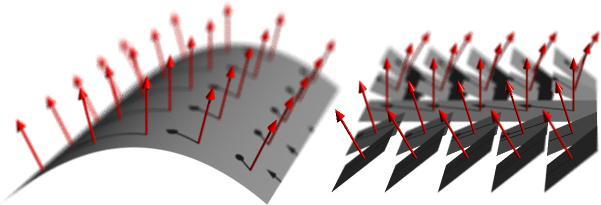Pixellated optics

Phase front (grey surfaces) and corresponding light-ray directions (phase-front normals; red arrows) for a globally continuous phase front (left) and a piecewise continuous phase front (right). The light-ray field is more restricted in the case of globally continuous phase fronts. We create piecewise continuous phase fronts by passing light fields through pixellated optical components.
Our group has pioneered micro-structured sheets that can perform very general light-ray-direction changes, but at the expense of introducing discontinuities into the phase front (see figure). As much of standard ray optics is informed by theorems derived for globally continuous phase fronts, ray optics with discontinuous phase fronts is not limited by those theorems. We explore the new possibilities.
Telescope windows are examples of such sheets: they consist of arrays of micro-telescopes, and they can be understood as pixellated optical components (each telescope being a pixel) which introduce, at the boundaries between neighbouring pixels, discontinuities into transmitted light beams. Telescope windows therefore remove the global continuity of phase fronts. If the pixel size is chosen appropriately, the pixellation can be almost unnoticeable.
Funded by EPSRC (EP/M010724/1 and EP/M010767/1), we are currently building the first demonstrators for new devices enabled by this technology.
More information is on the Telescope windows project site.
Contact: Johannes Courtial

